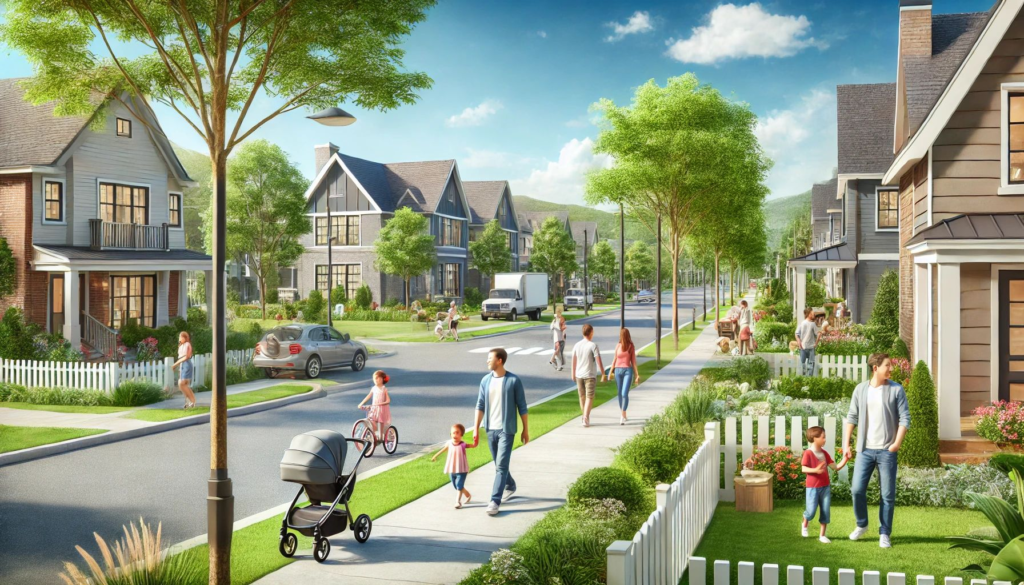
How to Choose the Perfect Neighborhood for Your Family
When it comes to finding the ideal home, choosing the right neighborhood is just as important as selecting the house itself. Your neighborhood influences your daily life, lifestyle, and long-term happiness. For families, this decision becomes even more crucial, as factors like safety, schools, and community support play a significant role in shaping the quality of life.
In this blog, we’ll guide you through the critical steps to choose the perfect neighborhood for your family.
—
1. Understand Your Family’s Priorities
Before diving into neighborhood options, list your family’s needs and preferences. Consider:
Proximity to Work: How far are you willing to commute daily?
Schools: If you have children or plan to, access to quality education is essential.
Amenities: Parks, grocery stores, medical facilities, and recreational areas are valuable.
Safety: Crime rates and general neighborhood security should be a top priority.
Community Culture: Does the neighborhood align with your family’s values and lifestyle?
—
2. Research Schools and Education Options
For families with children, education often becomes a driving factor in selecting a neighborhood. Look for:
School Ratings: Check online platforms like GreatSchools or local education boards for school ratings.
Proximity: Ensure schools are close enough for convenience but not so near that traffic becomes an issue.
Extracurricular Activities: A neighborhood with access to quality sports clubs, music schools, and libraries can enrich your child’s development.
—
3. Evaluate Safety and Security
Safety is non-negotiable for families. Here’s how to assess a neighborhood’s safety:
Crime Statistics: Use online resources like local government crime maps to understand the area’s safety.
Neighborhood Watch Programs: Check if the community has active programs that foster safety.
Street Lighting and Maintenance: A well-lit and well-maintained neighborhood is often safer.
—
4. Consider Accessibility and Convenience
A family-friendly neighborhood should be convenient for your daily needs. Check for:
Transportation: Are public transport options nearby? How is the road connectivity?
Proximity to Workplaces: Reducing commute times allows for more family time.
Essential Services: Ensure easy access to grocery stores, hospitals, and pharmacies.
—
5. Assess Housing Affordability and Growth Potential
Your dream neighborhood should fit your budget. Consider:
Home Prices: Look at current property values and whether they align with your financial plan.
Future Development: Research upcoming projects or developments that might affect property values.
Taxes: Understand property tax rates, which can vary significantly by neighborhood.
—
6. Visit the Neighborhood at Different Times
A neighborhood’s vibe can change depending on the time of day or week.
Day vs. Night: Ensure the area feels safe and welcoming at all times.
Weekday vs. Weekend: Check for noise levels, traffic, and activity during weekends.
Commute Time: Drive through the neighborhood during rush hours to assess traffic conditions.
—
7. Talk to Locals
The best way to get a feel for a neighborhood is by talking to the people who live there. Ask them about:
Community Events: Are there regular gatherings, festivals, or other family-friendly activities?
Hidden Issues: Learn about any potential problems that aren’t immediately obvious, like water shortages or noise pollution.
Overall Satisfaction: Are they happy living there?
—
8. Evaluate Green Spaces and Recreational Facilities
Families often prioritize neighborhoods with parks, playgrounds, and open spaces. Look for:
Parks: Are there well-maintained parks where children can play?
Sports Facilities: Access to tennis courts, swimming pools, or sports clubs can be a bonus.
Trails: Walking or biking trails promote outdoor activities for the whole family.
—
9. Check for Community Amenities
Community amenities can significantly enhance the quality of life. These include:
Clubs and Social Groups: A strong sense of community can make a neighborhood feel like home.
Childcare Services: Proximity to daycare centers or babysitting services is essential for working parents.
Cultural and Entertainment Options: Libraries, museums, and theaters contribute to a well-rounded family lifestyle.
—
10. Trust Your Instincts
Finally, trust your instincts. Sometimes, a neighborhood may check all the boxes but still not feel right. If something feels off, explore other options.
—
Conclusion
Choosing the perfect neighborhood for your family is a blend of research, priorities, and gut feeling. By considering safety, education, convenience, and community culture, you can make an informed decision that ensures happiness and stability for years to come.
FAQs: How to Choose the Perfect Neighborhood for Your Family
1. What are the most important factors to consider when choosing a neighborhood for a family?
The most critical factors include safety, access to quality schools, proximity to work and amenities, housing affordability, and the community’s overall vibe.
2. How can I determine if a neighborhood is safe?
You can research crime rates using online crime maps, talk to local residents, check for well-lit streets, and assess the presence of security measures like neighborhood watch programs.
3. What resources can help me research schools in a potential neighborhood?
Websites like GreatSchools, local school district websites, and reviews from other parents are excellent resources. You can also visit schools in person to evaluate facilities and staff.
4. How do I find out if a neighborhood has a strong sense of community?
Talking to current residents, visiting community events, or joining local social media groups can give you an idea of the neighborhood’s community spirit.
5. What are some red flags to watch out for when evaluating a neighborhood?
Red flags include frequent reports of crime, poorly maintained streets and parks, declining property values, heavy traffic, and a lack of essential services nearby.
6. Should I prioritize proximity to work or access to good schools?
It depends on your family’s specific needs. If you have children, quality schools may take precedence. However, a shorter commute can improve your work-life balance, giving you more time with family.
7. How can I evaluate future growth and development in a neighborhood?
Check local government planning offices or websites for details on proposed developments, infrastructure projects, or zoning changes that could affect the neighborhood.
8. Are there tools to calculate the affordability of a neighborhood?
Yes, tools like Zillow, Redfin, and Realtor.com allow you to view property prices, taxes, and estimated monthly payments. Don’t forget to factor in other costs like utilities and commuting expenses.
9. How can I ensure a neighborhood is family-friendly?
Look for features like parks, playgrounds, schools, daycare centers, and family-oriented community events. The presence of other families in the area is also a good sign.
10. Is visiting a neighborhood necessary before buying a property?
Yes, visiting a neighborhood is essential. It helps you experience the area’s vibe, assess noise levels, check traffic patterns, and identify potential issues that might not be evident online.
11. How do I balance my budget with finding the ideal neighborhood?
Start by prioritizing must-haves and nice-to-haves. Focus on neighborhoods that meet your critical needs while staying within your budget. Exploring nearby, less expensive areas can also be a good strategy.
12. How can I determine if a neighborhood has good amenities?
Explore the area for grocery stores, medical facilities, restaurants, parks, and recreational centers. You can also check online maps and reviews to evaluate these amenities.
13. What’s the best way to talk to locals about a neighborhood?
Strike up a conversation during visits to local parks, stores, or community events. Be polite and ask about their experiences living there, including the pros and cons of the area.
14. Can I rely on online research alone when choosing a neighborhood?
While online research is helpful, it shouldn’t replace visiting the neighborhood. Physical visits provide a clearer picture of the area’s vibe, safety, and suitability for your family.
15. How often should I revisit a neighborhood before making a decision?
It’s a good idea to visit multiple times, at different times of the day and week, to get a full understanding of traffic, noise levels, and daily life in the neighborhood.
For more guidance on finding your dream neighborhood and property, visit easypeopertydeal.com!
For more tips and property-related guidance, visit easypeopertydeal.com. Let’s make your dream home a reality!
